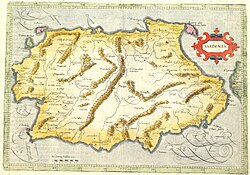
Sardinian ethnicity indicates genetic origins in Sardinia, which later became one of the 20 regions that constitute modern Italy, and is part of the broader Mediterranean world. Lying west of the Italian Peninsula, north of Tunisia in North Africa, and just south of the French island of Corsica, Sardinia is the second-largest island in the Mediterranean Sea. Often called a “micro-continent” for the diversity of its ecosystems, its natural landscape includes dense woods, wide plains, long sandy beaches, and precipitous mountains. Due to the relative isolation of the island’s population, Sardinians preserve an ancient Neolithic European genetic legacy. Today, communities of people of Sardinian descent can be found in other parts of Europe, including mainland Italy, Germany, and the United Kingdom, as well as in North Africa, Brazil, and Argentina.
Research your ancestors on MyHeritage
Sardinian history

The island of Sardinia has been continuously populated since prehistoric times. Between the 18th and 3rd centuries B.C.E., the island housed the enigmatic Nuragic civilization. The origin of Nuragic Sardinians is unknown, although archaeologists have suggested sea-faring tribes may have settled the island. As no written records from the period have been discovered, historians and archaeologists have yet to uncover how Nuragic people referred to themselves; rather, the Nuragic civilization derives its name from nuraghi — large stone structures in the shape of truncated cones — which have become emblematic of the Nuragic civilization. Over 7,000 nuraghi still exist on the island, and archaeologists believe that there were originally more than 10,000.
Starting around the 9th century B.C.E., the Phoenicians began to visit frequently and settle the island. By the 5th century B.C.E., the Carthaginians conquered and ruled large swaths of the island, only to be ousted by the Romans during the First Punic War in the 3rd century B.C.E. The Romans ruled Sardinia for nearly 700 years, during which time Sardinia served as a granary for the empire. In the 5th century C.E., the Vandals — a Germanic tribe that maintained a kingdom in North Africa — invaded Sardinia. Despite the best efforts of both the Western and Eastern Roman Empires, the Vandals held on to Sardinia for a century, until they were finally subdued by the Byzantine Empire. A series of incursions by the Iberian Moors in the 11th century were resisted only with the assistance of the combined navies of the city-states of Genoa and Pisa, after which Sardinia was divided into four self-governing judicates: Cagliari, Arborea, Torres, and Gallura.

Over the next 200 years, Sardinia came under the heavy influence of Pisa and Genoa. At the turn of the 14th century, despite the autonomy of the judicates, Pope Boniface VIII established the Kingdom of Sardinia and Corsica, handing the crown to King James II of the Iberian Kingdom of Aragon. The Aragonese, and later the Spanish monarchy, unified the administration of Sardinia and placed it under a viceroy residing at Cagliari. In the early 18th century, following the War of the Spanish Succession, Sardinia was passed first into the hands of Austria and later to the House of Savoy. Having exchanged the Kingdom of Sicily for Sardinia, the House of Savoy rapidly expanded, and led the unification of Italy in 1861. Savoyard kings ruled Italy until the Constitutional Referendum of 1946 which abolished the monarchy. Today, the region of Sardinia is 1 of 5 regions in Italy that enjoy a degree of domestic autonomy.
Sardinian culture

Located at the heart of the rich and culturally variegated Mediterranean world, Sardinia has absorbed influences from all around the basin. Furthermore, owing to the diverse geography of the island, the cuisine varies from area to area: Zuppa gallurese (“Gallurese soup”) — which, despite the name, looks more like lasagna than soup — is typical to Gallura, Sassari, and Olbia. Fregola, small balls of semolina dough, hail from Campidano, while lorighittas (“small rings”) — large, braided loops of semolina-based dough, often served with tomato sauce, pesto, or seafood — originate from province of Oristano. Some Sardinian dishes and products have become international favorites, including pecorino cheese and su porceddu: roasted suckling pig.
Sardinia has a rich local handicraft heritage which forms an important part of Sardinian culture. Having their roots in humble rural life, Sardinian handicrafts reflect a timeless rustic tradition. Basket-weaving, ceramics, pottery, tapestry, and carpets represent some of the most characteristic and varied expressions of Sardinian decorative art, each distinct in their manufacturing techniques, materials, designs, and colors. The richness of Sardinian culture is perhaps best encapsulated in the island’s colorful traditional clothing, which vary from village to village: from the color and cut of ladies’ skirts to the arrangement of scarves or headdress, and from the shape of men’s hats to the patterns and decorations that adorn each garment, each carefully hand-stitched item conforms to strict rules unique to its particular village.
Sardinian languages
Sardinian, or Sard, is a Romance language — a descendant of the Vulgar Latin introduced to the island by the Romans — and is spoken today by over 1,350,000 people in Sardinia. The language also carries varying degrees of pre-Latin elements, including the now-extinct Nuragic language, as well as traces of Byzantine Greek, Catalan, Spanish, and Italian influences. Despite the widespread use of Sardinian, Italian is the most common language spoken in Sardinia today, while other languages include Sassarese, Gallurese, Algherese, and Tabarchino.
See also
Explore more about ethnicity estimates
- MyHeritage DNA at MyHeritage
- Ethnicities around the world at MyHeritage
- What Is My Ethnicity? How MyHeritage Estimates Ethnicities at MyHeritage Knowledge Base
- Where's My Ethnicity?!: Why An Ethnicity Might Not Show Up In Your DNA (and How To Find Evidence Of It Anyway) at MyHeritage Knowledge Base


